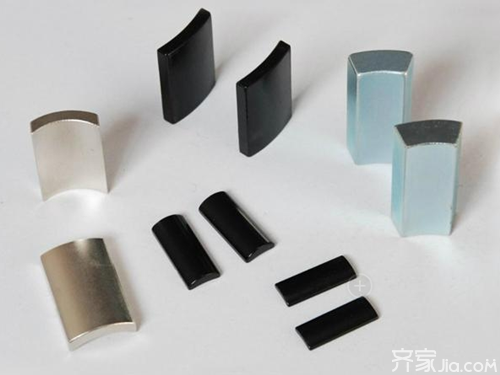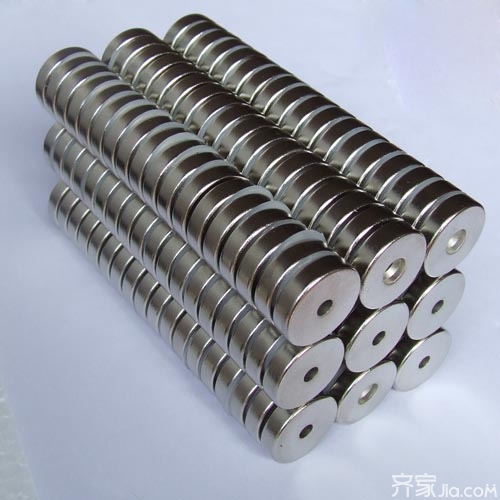Modern magnetic materials have been widely used in our lives, such as using permanent magnetic materials as motors, core materials used in transformers, magneto-optical disks used as memories, magnetic recording disks for computers and the like. It is generally considered that a magnetic material refers to a material that can directly or indirectly generate magnetism from excessive elements such as iron, cobalt, nickel, and alloys thereof. The difficulty of magnetic material demagnetization after magnetization can be divided into soft magnetic material and hard magnetic material. Here we talk about magnetic materials. The magnetic material has a magnetically ordered ferromagnetic substance, and in the broad sense also includes weak magnetic and antiferromagnetic substances to which its magnetic and magnetic effects can be applied. Magnetism is a basic property of matter. Substances can be classified into diamagnetic, paramagnetic, ferromagnetic, antiferromagnetic and ferrimagnetic materials according to their internal structures and their properties in external magnetic fields. Ferromagnetic and ferrimagnetic materials are ferromagnetic materials, and diamagnetic and paramagnetic materials are weak magnetic materials. Magnetic materials can be divided into two types, metal and non-metal. The former mainly include electrical steel, nickel-based alloys and rare earth alloys, and the latter are mainly ferrite materials. According to use, it is divided into soft magnetic material, permanent magnet material and functional magnetic material. Functional magnetic materials mainly include magnetostrictive materials, magnetic recording materials, magnetoresistive materials, bubble materials, magneto-optical materials, gyromagnetic materials, and magnetic thin film materials, etc. The basic magnetic properties of reactive magnetic materials have magnetization curves and hysteresis loops. And magnetic losses. Various magnetic material properties: Permanent magnetic material Once the external magnetic field is magnetized, it is possible to maintain the magnetism in one or most of the original magnetization direction even under a relatively large reverse magnetic field. The requirements for this type of material are high residual magnetic flux Br, high coercive force BHC (that is, resistance to demagnetization), and magnetic energy product (BH) magnetic material (that is, magnetic field energy supplied to space). It is also referred to as a hard magnetic material with respect to a soft magnetic material. Permanent magnetic materials include alloys, ferrites and intermetallic compounds. 1 alloys: including casting, sintering and machinable alloys. The main varieties of cast alloys are: AlNi (Co), FeCr (Co), FeCrMo, FeAlC, FeCo (V) (W); sintered alloys are: Re-Co (Re represents rare earth elements), Re-Fe, and AlNi (Co ), FeCrCo, etc.; Machinable alloys are: FeCrCo, PtCo, MnAlC, CuNiFe and AlMnAg, etc. The latter two in the lower BHC also known as semi-permanent materials. 2 Ferrites: The main component is MO·6Fe2O3, and M represents Ba, Sr, Pb or SrCa, LaCa and other composite components. 3 Intermetallic compounds: Mainly represented by MnBi. Permanent magnet materials have a variety of uses. 1 Based on the principle of electromagnetic force applications are: speakers, microphones, meters, buttons, motors, relays, sensors, switches and so on. 2 Based on the principle of magnetoelectricity application, there are mainly microwave electron tubes such as magnetrons and traveling wave tubes, picture tubes, titanium pumps, microwave ferrite devices, magnetoresistive devices, and Hall devices. 3 based on the principle of magnetic force applications are: magnetic bearings, mineral processing machines, magnetic separators, magnetic suckers, magnetic seals, magnetic blackboards, toys, signs, password locks, copiers, temperature control and so on. Other applications include magnetic therapy, magnetized water, and magnetic anesthesia. According to the needs of use, permanent magnetic materials can have different structures and shapes. Some materials also differ in isotropic and anisotropic properties. 2. Soft magnetic material Its function is mainly the conversion and transmission of magnetic and electromagnetic energy. Therefore, high magnetic permeability and magnetic induction are required for such materials, and the area or magnetic loss of the hysteresis loop is small. In contrast to permanent magnetic materials, the smaller the Br and BHC, the better, but the larger the saturation magnetic induction Bs, the better. Soft magnetic materials can be roughly divided into four categories. 1 alloy thin strip or sheet: FeNi (Mo), FeSi, FeAl and so on. 2 Amorphous alloy thin strips: Fe, Co, FeNi or FeNiCo bases with appropriate Si, B, P and other doping elements, also known as magnetic glass. 3 Magnetic medium (iron powder core): Powders of FeNi (Mo), FeSiAl, carbonyl iron, and ferrite, etc. are pressed and shaped as required after being coated and bonded with an electrically insulating medium. 4Ferrite: Including spinel type M++ O.Fe2O3 (M++ stands for NiZn, MnZn, MgZn, Li1/2Fe1/2Zn, CaZn, etc.), magnetoplumbite type-Ba3Me2Fe24O41 (Me stands for Co, Ni, Mg , Zn, Cu and their composite components). Soft magnetic materials are widely used and are mainly used for magnetic antennas, inductors, transformers, magnetic heads, headphones, relays, oscillators, TV deflection yokes, cables, delay lines, sensors, microwave absorbing materials, electromagnets, and accelerators for high-frequency acceleration Cavity, magnetic field probes, magnetic substrates, magnetic field shielding, high-frequency quenching, electromagnetic chucks, magneto-sensitive elements (such as magnetic thermal material for switching). 3. Momentum magnetic material and magnetic recording material Mainly used for information recording, no contact switch, logic operation and information amplification. This material is characterized by a rectangular hysteresis loop. 4. Magnetic material It has unique microwave magnetic properties such as tensor characteristics of magnetic permeability, Faraday rotation, resonance absorption, field shift, phase shift, birefringence, and spin waves. The devices thus designed are mainly used for the transmission and conversion of microwave energy. Commonly used are isolators, circulators, filters (fixed or electronic), attenuators, phase shifters, modulators, switches, limiters, and Delay lines, etc., as well as magnetic surface wave and magnetostatic wave devices are still under development (see microwave ferrite devices). The commonly used materials have been formed into series, including ferrite materials such as Ni-based, Mg-based, Li-based, YlG-based, and BiCaV-based systems; various structures such as monocrystalline, polycrystalline, amorphous, or thin films can be made as required by the device. And morphology. 5. Magnetic materials This kind of material is characterized by mechanical deformation under the action of an external magnetic field. It is also called a magnetostrictive material. Its function is to convert magneto-acoustic or magnetic energy. It is commonly used in vibration generators for ultrasonic generators, mechanical filters for communication machines, and delay lines for electrical pulse signals. In combination with microwave technology, microsonic (or phonoacoustic) devices can be produced. Due to the high mechanical strength of the alloy material, which is resistant to vibration without bursting, Ni-based alloys and NiCo-based alloys are often used as the vibrating heads, and Ni-based and NiCo-based ferrites are often used as the vibrating heads. New varieties of amorphous magnetic alloys with higher pressure magnetic properties are suitable for making delay lines. The production and application of piezoelectric materials is far less than the previous four materials. 6. Application of Magnetic Materials Magnetic materials are widely used materials in production, life, defense science and technology. Such as manufacturing various kinds of motors, transformers in power technology, various magnetic components and microwave tubes in electronic technology, filters and sensitizers in communication technology, magnetic mines in electromagnetic technology, electromagnetic guns, various household appliances, etc. . In addition, magnetic materials have also been widely used in geological exploration, marine exploration, and new technologies in information, energy, biology, and space. The use of magnetic materials is very wide. The above is the introduction of magnetic materials by Xiao Bian. I hope to help everyone, and I would like to know more about the relevant knowledge. Decoration Materials Brand Decoration Materials List Decoration Materials Knowledge Hydroelectric Material Brand Import Alloy Saw Blade Aluminium Chequered Plate,Aluminium Sheet,5083 Aluminum Plates,Aluminium Chequered Plates Zhengzhou Yearshine Industry Co., Ltd , https://www.zzyscorp.com


Various magnetic material properties
